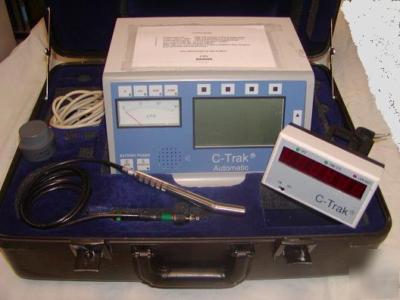Machine Recycling Discussion and Moderated Newsgroup > Components
> Wheels and Bearings
> West
> C-trak automatic analyzer surgical guidance system
C-trak automatic analyzer surgical guidance system
C-Trak Automatic Analyzer Surgical Guidance System
for Sentinel Lymph Node Diagnostics
The C-Trak Surgical Guidance System from Care Wise has been designed to be used by a surgeon in identifying tissues which contain a radioisotope label. The heart of the system is a small, hand-held gamma detector, the C-Trak probe. With this probe, the surgeon can also determine whether surgically removed tissue contains radioisotope material and, by repeated assay, can determine whether all radioisotope containing material has been removed from the operative site.
C-Trak probes are capable of measuring gamma energies up to 364 keV, and are designed to detect small sites of radioisotope uptake in the high scatter, highly variable background environments found with imaging radiolabels such as Indium 111 and Technetium 99m. The C-Trak Omniprobe PET can be used to detect higher-energy radiolabels such as FDG, with energies up to 600 keV.
Achieving this level of performance is possible because of the probe's proprietary combination of variable collimation and shielding, coupled to the signal discrimination of the C-Trak analyzer.
Patented, snap-on collimators vary the probe's field of view from wide (for surveying) to narrow (for probe-guided resection), and can be matched to suit tissue/background levels. The use of the patented C-Trak blocking plate, in combination with the collimators, allows the surgeon to reduce radiation from outside the selected field of view.
The head of the compact 5" probe is angled at 30 degrees to facilitate surgical searches in tight anatomical spaces such as the pelvis.
This unit come with Gamma probe and External LED Display .
A gamma probe is an instrument used to detect radiation in patients. It functions a bit like a small and highly directional Geiger counter, and is designed principally for use in surgery.
Surgeons often find it difficult to locate tissues, such as tumours, parathyroid glands, and lymph nodes, within the human body. Unlike what anatomy textbooks may lead one to believe, there is a fair amount of anatomical variation from one patient to the next, and soft tissues move around, so surgeons are trained to explore until they find the tissues they seek. This exploration is a difficult task, and gamma probes aid considerably in the process of exploration in a number of surgical procedures. Proper use of a gamma probe allows the surgeon to make a smaller incision and have greater confidence that exploration was successful, and the tissues of interest have been located.
In general, the patient is injected with a solution that has a radioactive element. The solution moves through the body to the tissues to be located, and then emits radiation there. The surgeon can then use a gamma probe to locate the source of radiation uptake, and thus indirectly find the tissues of interest.
One of the most common uses of gamma probes is in a surgical procedure called a Sentinel Node Biopsy. Sentinel Node Biopsies can be used to determine whether a tumour has metastasized, or spread to new locations. Sentinel Node Biopsies are common for staging breast cancer and melanoma, and are becoming increasingly popular in staging other forms of cancer. Sentinel Node Biopsies most commonly use a radioisotope called Technetium-99m, and most C-Trak probes are optimized for detection of this isotope.
C-Trak OmniProbe PET systems can also be used to detect very high-energy radioisotopes such as Flourine-18, which is commonly delivered in a solution called FDG. FDG can be used to find a wide variety of types of cancer, and has a promising outlook for future development.
This System in perfect condition come with all accessory , user manual and original Mobile case .
The M.S.R. Price for the unit only without Accessory $24000.00

